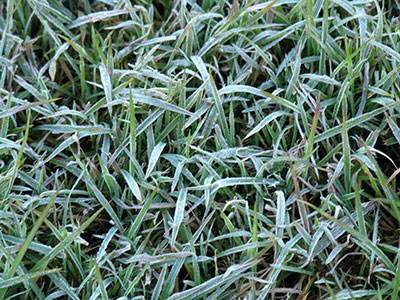How to Help Your Lawn Survive the Chill

Certainly when we think of living in Florida, we do not generally think about losing our lawns to freezing temperatures. However, some homeowners in Florida may find themselves needing to replace portions of their lawn in the spring due to the cold weather. Here are some tips about how to prevent or reduce winterkill by preparing your lawn for the winter months and how to let your lawn recover from the big chill with minimal damage.
Preparing Your Lawn for Winter
All of our warm season turfgrass species go into some degree of dormancy during the winter months, slowing their growth down and they may or may not stay green. This is a natural cycle, regardless of where you live in the state. In North and even Central Florida, lawns may stay green or may turn brown, either of which can be normal. Even in South Florida, lawns do not grow as quickly in the winter, even though they may remain green (less mowing required!). Regardless of where you are in the state, you should work to keep your lawn as healthy as possible through mowing, irrigating, and fertilizing practices. For more information on how to properly manage your lawn, please refer to Best Management Practices for Your Lawn.
Lawns in South Florida are typically fertilized year-round with no problems. However, Central and North Florida lawns should not be fertilized after mid-September or late September. The last fertilization should be done with a fertilizer containing higher or equal amounts of potassium (the third number on the bag) relative to nitrogen (the first number on the bag), such as 15-0-15. This helps to impart some stress tolerance to cold or freezing temperatures and may enhance spring greenup. In Central Florida, do not fertilize lawns between October and the end of March. In North Florida, avoid fertilizing from mid-September through mid-April. Keep mowing height high year-round for additional enhanced stress tolerance (3.5″ to 4″ for most St. Augustinegrass cultivars and bahiagrass and 2″ to 2.5″ for centipedegrass and coarse-textured zoysiagrass lawns).
Coming Out of the Freeze
Freezing temperatures will turn lawns brown. Do not panic, this is a normal part of winter dormancy. When the days become longer and temperatures start to warm up in the spring, the growing points will become active, bringing green growth to the lawn again. Do not fertilize your lawn in the winter to try to green it up after a freeze—wait for the natural cycle of events to occur in the springtime. Fertilizing after a freeze will do more harm to your lawn than waiting for spring green-up. Do not apply a weed and feed product for preemergence weed control during the winter in Central and North Florida. Lawns generally do not require as much irrigation during winter months, so scale back your irrigation systems. In Central Florida, you may need to irrigate weekly or every other week, while in North Florida, it may be every three to four weeks. You will not need to mow for some time; when you do need to mow again, be sure to cut at the highest recommended height for your grass type. Do not “scalp” the lawn, as this makes it less able to recover from freeze damage.
How can you tell if your grass has truly succumbed to a winter freeze or if it is only dormant? One way is to cut small plugs of the grass (with roots and shoots attached) and plant them in a pot, put it in a warm spot with natural sunlight and see if the grass begins to grow.
If your lawn does not recover come springtime, remove the decayed vegetation from the affected areas and replace with either sod pieces or plugs. Do this before weeds have a chance to germinate and take hold of the ground. It is possible that not all of your lawn will be affected, perhaps just those areas that are most exposed to the cold temperatures.
Following these tips will help your lawn survive freezing temperatures.
Contacts
- Dr. Bryan Unruh
Associate Professor
Extension Turfgrass Specialist
UF Environmental Horticulture
Also on Gardening Solutions
Written by Dr. Laurie Trenholm, retired.
